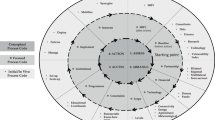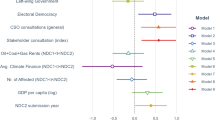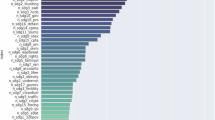Abstract
Parties to the Paris Agreement submit their climate action plans, known as nationally determined contributions (NDCs), which outline mitigation targets and strategies to achieve them. While existing research has focused on assessing the mitigation targets, there is a wealth of broader textual content within the documents that has received little attention. Using natural language processing to systematically analyse the full textual content of all NDCs, we identify 21 topics that form seven thematic groups: development, implementation and planning, mitigation targets, policies and technologies, climate change impacts, agriculture and ecosystems, and stakeholders. We also examine how attention to specific topics has evolved over time and across parties. We find that high-income countries, typically shouldering greater historical responsibility for emissions, tend to focus on mitigation targets but provide limited detail on concrete policies being implemented. In contrast, developing countries often frame their NDCs within broader visions of sustainable development, balancing mitigation with adaptation and competing development goals. Establishing a standardized, transparent NDC format could enhance comparability of the plans of parties and assessment of how mitigation targets will be achieved while balancing trade-offs and co-benefits with other sustainable development goals.
This is a preview of subscription content, access via your institution
Access options
Access Nature and 54 other Nature Portfolio journals
Get Nature+, our best-value online-access subscription
$32.99 / 30 days
cancel any time
Subscribe to this journal
Receive 12 digital issues and online access to articles
$119.00 per year
only $9.92 per issue
Buy this article
- Purchase on SpringerLink
- Instant access to full article PDF
Prices may be subject to local taxes which are calculated during checkout


Similar content being viewed by others
Data availability
The data are available at https://github.com/IvanVSavin/ParisAgreementNDCs43.
Code availability
The computer code is available at https://github.com/IvanVSavin/ParisAgreementNDCs43.
References
Höhne, N., Fekete, H., den Elzen, M. G. J., Hof, A. F. & Kuramochi, T. Assessing the ambition of post-2020 climate targets: a comprehensive framework. Clim. Policy 18, 425–441 (2017).
Tørstad, V., Sælen, H. & Bøyum, L. S. The domestic politics of international climate commitments: which factors explain cross-country variation in NDC ambition? Environ. Res. Lett. 15, 024021 (2020).
Rogelj, J. et al. Paris Agreement climate proposals need a boost to keep warming well below 2 °C. Nature 534, 631–639 (2016).
Ou, Y. et al. Can updated climate pledges limit warming well below 2 °C? Science 374, 693–695 (2021).
Meinshausen, M. et al. Realization of Paris Agreement pledges may limit warming just below 2 °C. Nature 604, 304–309 (2022).
Senshaw, D. A. & Kim, J. W. Meeting conditional targets in nationally determined contributions of developing countries: renewable energy targets and required investment of GGGI member and partner countries. Energy Policy 116, 433–443 (2018).
Pauw, W. P., Castro, P., Pickering, J. & Bhasin, S. Conditional nationally determined contributions in the Paris Agreement: foothold for equity or Achilles heel? Clim. Policy 20, 468–484 (2019).
Craft, B. & Fisher, S. Measuring the adaptation goal in the global stocktake of the Paris Agreement. Clim. Policy 18, 1203–1209 (2018).
Morgan, E. A., Nalau, J. & Mackey, B. Assessing the alignment of national-level adaptation plans to the Paris Agreement. Environ. Sci. Policy 93, 208–220 (2019).
King, L. C. & van den Bergh, J. C. J. M. Normalisation of Paris agreement NDCs to enhance transparency and ambition. Environ. Res. Lett. 14, 084008 (2019).
Pauw, W. P. et al. Beyond headline mitigation numbers: we need more transparent and comparable NDCs to achieve the Paris Agreement on climate change. Clim. Change 147, 23–29 (2017).
Emissions Gap Report 2023: Broken Record—Temperatures Hit New Highs, yet World Fails to Cut Emissions (Again) (UNEP, 2023).
Fransen, T. et al. Taking stock of the implementation gap in climate policy. Nat. Clim. Change 13, 752–755 (2023).
Dugoua, E., Dumas, M. & Noailly, J. Text as data in environmental economics and policy. Rev. Environ. Econ. Policy 16, 346–356 (2022).
Nikolenko, S. I., Koltcov, S. & Koltsova, O. Topic modelling for qualitative studies. J. Inf. Sci. 43, 88–102 (2017).
Creutzig, F. et al. Reviewing the scope and thematic focus of 100 000 publications on energy consumption, services and social aspects of climate change: a big data approach to demand-side mitigation. Environ. Res. Lett. 16, 033001 (2021).
Asmussen, C. B. & Møller, C. Smart literature review: a practical topic modelling approach to exploratory literature review. J. Big Data 6, 93 (2019).
Savin, I. & van den Bergh, J. Main topics in EIST during its first decade: a computational-linguistic analysis. Environ. Innov. Soc. Transit. 41, 10–17 (2021).
Savin, I., Drews, S. & van den Bergh, J. Carbon pricing–perceived strengths, weaknesses and knowledge gaps according to a global expert survey. Environ. Res. Lett. 19, 024014 (2024).
Savin, I. Evolution and recombination of topics in technological forecasting and social change. Technol. Forecast. Soc. Change 194, 122723 (2023).
King, L. C., Savin, I. & Drews, S. Shades of green growth scepticism among climate policy researchers. Nat. Sustain. 6, 1316–1320 (2023).
Rogelj, J. et al. Credibility gap in net-zero climate targets leaves world at high risk. Science 380, 1014–1016 (2023).
Barrett, S. Choices in the climate commons. Science 362, 1217 (2018).
Climate Watch Data Explorer, NDC Text in HTML (World Resources Institute, accessed 31 May 2023); https://www.climatewatchdata.org/data-explorer/
Nationally Determined Contributions Registry (UNFCCC, accessed 31 May 2023); https://unfccc.int/NDCREG
Gütschow, J., Günther, A. & Pflüger, M. The PRIMAP-hist national historical emissions time series (1750–2019) v2.3.1 (2.3.1) [Data set]. Zenodo https://doi.org/10.5281/zenodo.5494497 (2021).
Blei, D. M. Probabilistic topic models. Commun. ACM 55, 77–84 (2012).
Savin, I., Drews, S., Maestre-Andrés, S. & van den Bergh, J. Public views on carbon taxation and its fairness: a computational-linguistics analysis. Clim. Change 162, 2107–2138 (2020).
Tvinnereim, E. The energy efficiency gap in citizens’ own words. Nat. Energy 8, 915–916 (2023).
Roberts, M. E. et al. Structural topic models for open‐ended survey responses. Am. J. Political Sci. 58, 1064–1082 (2014).
Roberts, M. E., Stewart, B. M. & Tingley, D. stm: an R package for structural topic models. J. Stat. Softw. 91, 1–40 (2019).
Savin, I., Ott, I. & Konop, C. Tracing the evolution of service robotics: Insights from a topic modeling approach. Technol. Forecast. Soc. Change 174, 121280 (2022).
Hsu, A. et al. Performance determinants show European cities are delivering on climate mitigation. Nat. Clim. Change 10, 1015–1022 (2020).
Devlin, J. BERT: pre-training of deep bidirectional transformers for language understanding. In Proc. of the 2019 Conference of the North American Chapter of the Association for Computational Linguistics: Human Language Technologies, Volume 1 (Long and Short Papers) 4171–4186 (ACL, 2019).
Bingler, J. A., Kraus, M., Leippold, M. & Webersinke, N. Cheap talk and cherry-picking: what ClimateBert has to say on corporate climate risk disclosures. Financ. Res. Lett. 47, 102776 (2022).
Savin, I., Chukavina, K. & Pushkarev, A. Topic-based classification and identification of global trends for startup companies. Small Bus. Econ. 60, 659–689 (2023).
Tvinnereim, E. & Fløttum, K. Explaining topic prevalence in answers to open-ended survey questions about climate change. Nat. Clim. Change 5, 744–747 (2015).
Gütschow, J. et al. The PRIMAP-hist national historical emissions time series. Earth Syst. Sci. Data 8, 571–603 (2016).
World Population Prospects (United Nations, 2019); https://population.un.org/wpp
National Accounts Statistics: Main Aggregates and Detailed Tables (UNSD, 2023); https://unstats.un.org/unsd/nationalaccount
Country Index (Notre Dame Global Adaptation Initiative, 2023); https://gain.nd.edu/our-work/country-index
World Bank Open Data (World Bank, 2023); https://data.worldbank.org
Savin, I. et al. ParisAgreementNDCs. GitHub https://github.com/IvanVSavin/ParisAgreementNDCs (2024).
Acknowledgements
This work contributes to the ‘María de Maeztu’ Programme for Units of Excellence of the Spanish Ministry of Science and Innovation (CEX2019-000940-M). This study received funding under the Horizon Europe programme through an ERC Advanced Grant for the project CLIMGROW (grant no. 101097924). We thank P. Winker for helpful suggestions.
Author information
Authors and Affiliations
Contributions
I.S. and L.C.K. conceived the research. I.S., L.C.K. and J.v.d.B. wrote the paper. I.S. and L.C.K. gathered the data. I.S. performed the computational analysis and L.C.K. performed the qualitative analysis. I.S. and L.C.K. produced the visualizations.
Corresponding author
Ethics declarations
Competing interests
The authors declare no competing interests.
Peer review
Peer review information
Nature Sustainability thanks Marion Dumas and the other, anonymous, reviewer(s) for their contribution to the peer review of this work.
Additional information
Publisher’s note Springer Nature remains neutral with regard to jurisdictional claims in published maps and institutional affiliations.
Supplementary information
Supplementary Information
Supplementary Figs. 1–7, Tables 1 and 2 and Notes 1–3.
Supplementary Data
NDC documents with topic prevalences for topics T1–T21.
Rights and permissions
Springer Nature or its licensor (e.g. a society or other partner) holds exclusive rights to this article under a publishing agreement with the author(s) or other rightsholder(s); author self-archiving of the accepted manuscript version of this article is solely governed by the terms of such publishing agreement and applicable law.
About this article
Cite this article
Savin, I., King, L.C. & van den Bergh, J. Analysing content of Paris climate pledges with computational linguistics. Nat Sustain 8, 297–306 (2025). https://doi.org/10.1038/s41893-024-01504-6
Received:
Accepted:
Published:
Issue date:
DOI: https://doi.org/10.1038/s41893-024-01504-6



